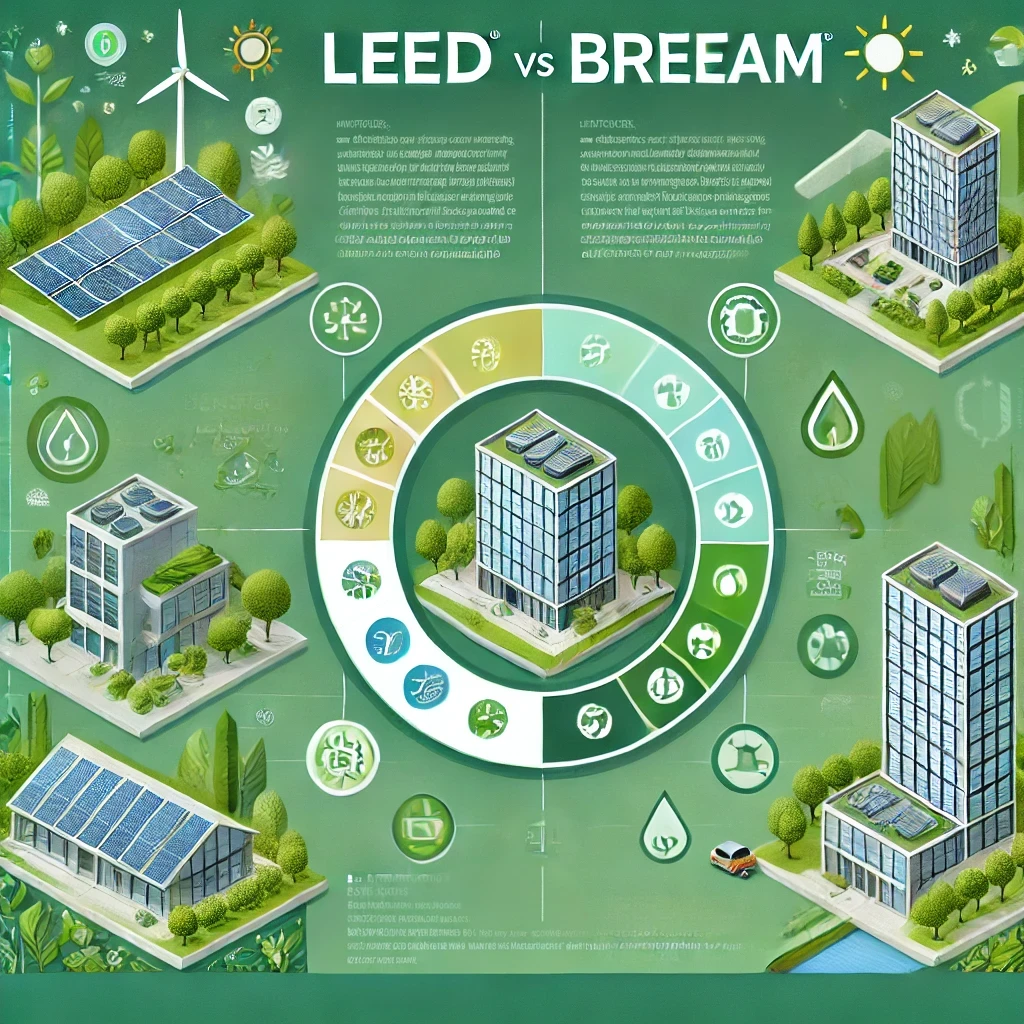As sustainability becomes a top priority in the built environment, various green building certification systems have emerged to guide and standardize sustainable construction practices. Two of the most recognized systems are LEED (Leadership in Energy and Environmental Design) and BREEAM (Building Research Establishment Environmental Assessment Method). While both aim to enhance building sustainability, they differ in assessment criteria, certification approach, and regional influence.
This guide explores the key differences between LEED and BREEAM, helping project teams select the most suitable certification for their buildings.
What is LEED?
LEED, developed by the U.S. Green Building Council (USGBC), is a globally recognized green building certification system. It provides a flexible framework for designing, constructing, and operating buildings with a focus on energy efficiency, resource conservation, and environmental responsibility.
LEED Certification System
LEED operates on a point-based system, where projects earn credits in key sustainability areas, such as:
Energy efficiency
Water conservation
Sustainable materials
Indoor air quality
Site sustainability
Projects are awarded one of four LEED certification levels, depending on their total points:
Certified (40–49 points)
Silver (50–59 points)
Gold (60–79 points)
Platinum (80+ points)
What is BREEAM?
BREEAM, developed by the Building Research Establishment (BRE) in the UK, is one of the oldest sustainability assessment methods for buildings. It provides a structured framework for evaluating a building’s environmental performance across multiple categories.
BREEAM Certification System
BREEAM scores projects based on weighted sustainability categories, including:
Energy efficiency
Water use
Health & well-being
Pollution control
Transportation & accessibility
Materials & waste management
Each category has a weighted score, and the final project rating falls into one of the following BREEAM certification levels:
Pass (≥30%)
Good (≥45%)
Very Good (≥55%)
Excellent (≥70%)
Outstanding (≥85%)
Key Differences Between LEED and BREEAM
| Feature | LEED | BREEAM |
|---|---|---|
| Developed By | USGBC (USA) | BRE (UK) |
| Global Reach | Widely used worldwide | Primarily in Europe, expanding globally |
| Assessment Method | Point-based credit system | Weighted category-based system |
| Certification Levels | Certified, Silver, Gold, Platinum | Pass, Good, Very Good, Excellent, Outstanding |
| Energy Efficiency | Strong emphasis on energy modeling and verification | Focuses on energy efficiency and operational carbon footprint reduction |
| Water Efficiency | Prioritizes water use reduction and metering | Assesses water management holistically |
| Indoor Air Quality | Strong focus on air quality, daylighting, and comfort | Covers health & well-being with a broader sustainability scope |
| Renewable Energy | Rewards on-site renewable energy use | Encourages lifecycle environmental impact consideration |
| Flexibility | More flexibility in credit selection | Uses a structured weighted score system |
| Regional Adoption | Popular in North America, Middle East, and Asia | Predominantly used in Europe, growing internationally |
Regional Influence and Popularity
LEED is widely adopted in North America, the Middle East, and Asia, where it aligns with market-driven sustainability incentives and energy efficiency priorities.
🇪🇺 BREEAM is the dominant certification in Europe, especially in the UK, where regulatory frameworks are closely aligned with its category-based assessment approach.
Which Certification is Best for Your Project?
Choose LEED if:
Your project is located in North America, the Middle East, or Asia.
You prioritize energy efficiency and innovation.
You want a globally recognized certification.
Your project is commercial, institutional, or large-scale residential.
Choose BREEAM if:
Your project is in Europe or the UK.
You prefer a structured category-weighted assessment.
You want a strong focus on lifecycle sustainability and building resilience.
Your project is a new or existing development needing a holistic environmental assessment.
Conclusion
Both LEED and BREEAM provide strong sustainability frameworks but differ in approach, certification structure, and regional focus.
LEED takes a market-driven, energy-efficient approach, making it ideal for large-scale projects worldwide.
BREEAM follows a structured, category-based evaluation, making it the preferred choice in the UK and Europe.
By understanding their unique characteristics, project teams can choose the most suitable certification to align with their sustainability objectives and contribute to a greener future.

